1 in almost 4 marketers say that the reason they invest in influencer marketing is for that sweet, sweet, influencer-generated content.
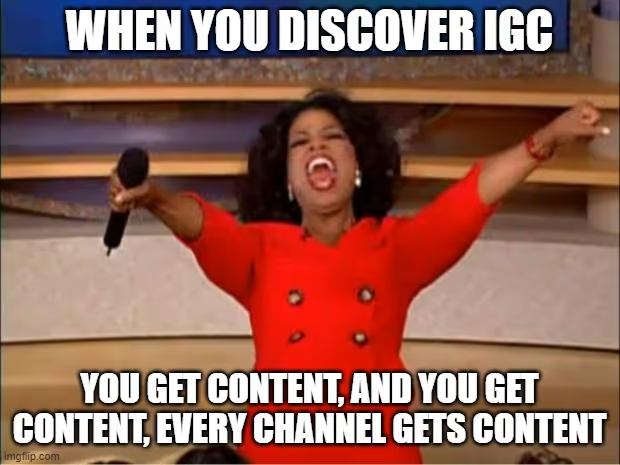
And they’ve got the right idea. The benefits of influencer-generated content make every part of a marketer's job easier. In fact, we’re here to tell you that content production should be part of influencer marketing KPIs and a core part of your overall strategy.
What can influencer-generated content do for your brand?
- Scale user-generated content
- Simplify and amplify your content creation process
- Spend less money on better quality content
- Improve performance in other channels
- Give you a better return on investment than traditional channels
Before we unpack these benefits, let’s get on the same page about definitions.
The difference between influencer-generated content & user-generated content
Before the rise of influencers and influencer-generated content (IGC), there was user-generated content (UGC).
What is user-generated content?
User-generated content is any content created by individuals and published online or on social networks. This includes Facebook, YouTube, Instagram, TikTok, Twitter, Tumblr (Yes, it’s still around!), blogs, LinkedIn and the list goes on.
It’s the kind of content that users create on their own, inspired by experiences they sought on their own.
What is influencer-generated content?
Influencer-generated content is a subset of user-generated content. By definition, it’s any content – text, images, or videos created by influencers, usually in partnership with brands, and published online or on social networks.
Influencer-generated content is driven by brands. In return for the content they produce, brands compensate the influencer.
IGC vs UGC. Which one is better for your brand?
As digital marketing matures, so does the consumer. Surveys have consistently found that consumers trust user-generated content more than any other type of content.
Recently, Oracle found that 37% of consumers trust influencers over brands. That number doubled when they isolated Millennials and Gen Z. In 2019, the Edelman Trust Index found a similar finding. 63% of Millennials consumers surveyed said they trust influencers over brands.
Cross-reference these findings with results from The State of User-Generated Content 2022, where they found that 39% of those surveyed don’t trust influencers, and we begin to see a pattern emerge.
As humans, we trust:
- Friends, family, and others like us first
- Influencers
- Celebrities
- Brands
Within this context, influencer-generated content seems like a must-have. So, let’s take a look and see what it can do.
The benefits of influencer-generated content for your brand
1. IGC scales user-generated content
Influencer-generated content is the wind beneath user-generated content’s wings.
Since we know that consumers trust user-generated content over any other content type and we also know that UGC isn’t in a marketer's full control, relying on IGC is the next best thing.
Because influencer-generated content can kickstart and scale UGC.
When influencers post content about brands to an engaged audience, it can create a loop. A follower will purchase said item and tag the influencer who influenced them. The influencer then reposts that user-generated content, inspiring more followers to purchase the product and create content.
Takeaway: Don’t take follower count at face value. Instead, look for higher engagement rates. You’ll find more success with creators and influencers who not only have an engaged following but who have built a sense of trust and community around their personal brand.
2. IGC simplifies your content creation process
Creating the sheer volume of content you need to fill various marketing channels and getting the right attention to that content requires an overwhelming amount of creativity, hours, and resources. Not to mention the number of Google docs, Asana/Notion boards, and Airtable sheets you’re using to keep it all on track.
If you’ve ever thought to yourself, “There must be a better way!” Influencer-generated content is that way.
Influencers don’t only come with a built-in distribution channel but they become your copywriters, creative strategists, models, photographers, and videographers all in one.
While managing an influencer marketing program does require hands-on work, it doesn’t need as many people as creating original content does.
For example, Modash customer Volant, manages an average of 750 influencers monthly, generating 12,000 pieces of reusable branded content. All with only 3 team members.
Imagine how many boards, tasks, sub-tasks, and dependents, it would take to create 12, 000 pieces of content?
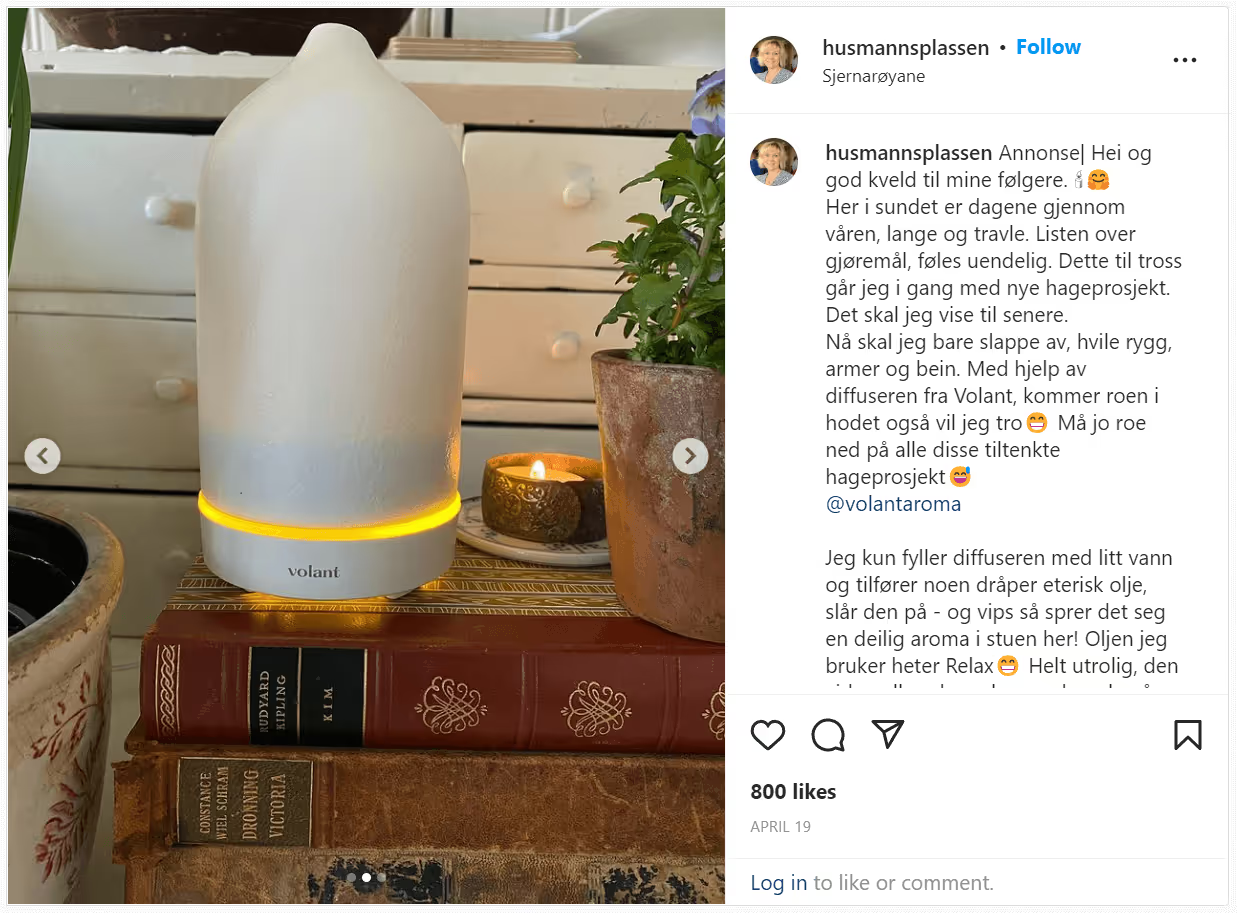
“Outsourcing” part of your content creation process to influencers frees you up to focus on more strategic marketing activities.
Takeaway: Working with just 30 influencers who create 2-3 pieces of content a month will produce over 60 pieces of original content for you. And if you negotiate usage rights you’ll be able to repurpose and repackage that content for other channels like email, ads, and even your website.
3. IGC is more cost-effective for producing quality content
By simplifying the content creation process and repurposing IGC, influencer-generated content can save you money on content production.
Video content, for example, can cost over $1000 per video, and that's on the low end. And then you still need to distribute that content and hope it gets traction.
Influencers on Instagram, TikTok, and YouTube will create and share content with an audience that already trusts them for as little as $20 per 1000 followers.
Don’t get it twisted though. Influencer marketing is not cheap (The one mil per post for the Kardashians is a case in point.). Rather, influencer-generated content can be more affordable and more cost-effective for the value it provides.
Influencer rates are often based on their follower number, engagement, and reach. The better those metrics, the higher the rate will be.
You can quickly find any influencer’s engagement rate using our free engagement rate calculator or in Modash’s influencer reports.
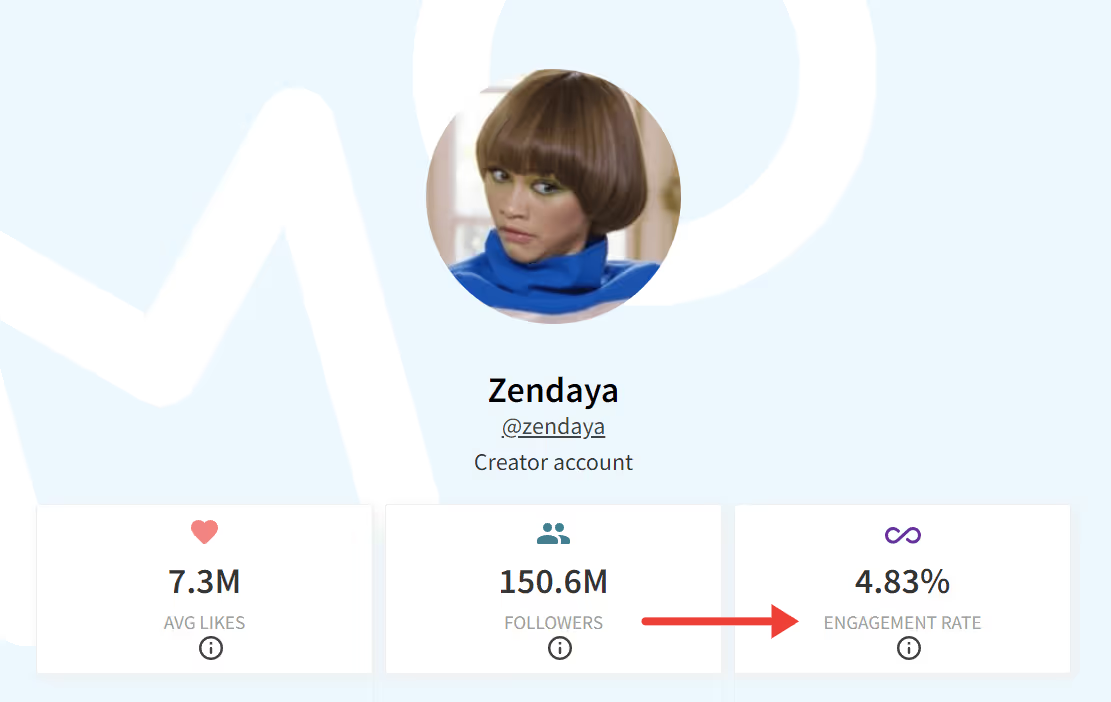
Takeaway: Saving money on resources and investing it in other areas of marketing or your business can give you the power to unlock other opportunities.
4. IGC improves performance on other channels
Not only do consumers say they trust influencer-generated content over branded content, but quite often using IGC can improve performance on other channels.
Here’s what we mean:
Say you run an influencer marketing campaign and you notice that an Instagram post by creator X is getting tons of engagement organically. This is a sign that the post has resonated with the audience.
Using that influencer-generated content as an ad creative instead of running branded content will most likely bring better outcomes.

In a study, when researchers compared branded social media ads to IGC, they found that while engagement (likes, comments, shares) was higher on social media ads, IGC generated more sales.
Takeaway: Influencer-generated content should be part of a blended marketing strategy. Don’t silo it! Instead, use influencer-generated content as a test to discover what kind of content performs well and then distribute that high-performing IGC content on other channels, including paid ad creatives.
5. IGC has shown to have a good return on investment
So far we’ve seen that IGC can lower costs and improve sales leading to a potentially better return on investment, right? If you’re here looking for a shocking number to get buy-in from mon-marketing execs, you won’t find it here.
It’s still a challenge to measure and report on ROI in a reliable way. And the most common number you see cited (11%) came from a single case study and should only be used anecdotally.
At Modash we’ve seen customers get a 6% return on ad spend. And in her experience, Taylor Lagace from Kynship finds that “DTC brands get an average 6.5x return on every dollar they spend with influencer marketing.”
No one can guarantee a certain ROI on influencer marketing. Because it will depend on your goals, your measurement, your industry, your product, your campaigns, and the content created.
Arguably, you can make a solid business case for it by answering the question, “What will we lose if we don’t try it?”
The good news is that influencer marketers in the trenches agree that the channel is more often underestimated rather than overestimated.
How to measure the impact of influencer-generated content on your business
Some key metrics you can use to track to measure the success and ROI of influencer-generated content are:
- The sum of content (including images, reels, and videos) created per campaign
- The sum of content produced per influencer: You may want to increase the volume of posting, especially among your high-performing creators. This will give you more content to repurpose and put your brand in front of more eyeballs.
- Total spend on content: This will almost always be the amount you spent on recruiting influencers, influencers fees including the cost of goods sent, postage, etc.
- Media value: How much would you end up paying if you were to use ads to achieve the same results?
- Ad performance uplift: Compare the performance between IGC creative and brand creative in your paid ads. If IGC creative performs better, it’s reasonable to attribute that uplift in ROI to IGC.
Learn 8 different ways to track clicks and sales generated by IGC so you can better measure the impact of influencer marketing on your brand.
Takeaway: Focus on improving the way you track and measure success with each campaign. And don’t forget to add content production as a KPI. Quite often, cost savings gives you the space and time to unlock the benefits of a new channel.
How to work with influencers on IGC
Working with creators on influencer-generated content can be a multi-step process at scale. Here we’ve chosen 3 important steps you don’t want to miss.
1. Find the right influencers
On a scale of 1 to viral, working with the right influencers is key to great influencer-generated content. What does the right influencer look like though? That depends on your brand, your goals for influencer marketing, and your budget.
If we were to choose one characteristic that makes a good influencer it would be this: their audience is a match to your target audience.
So, finding the right influencers starts with knowing who your target audience is. In Modash, you can search for influencer audiences by demographics like location, gender, age, language, and interests.
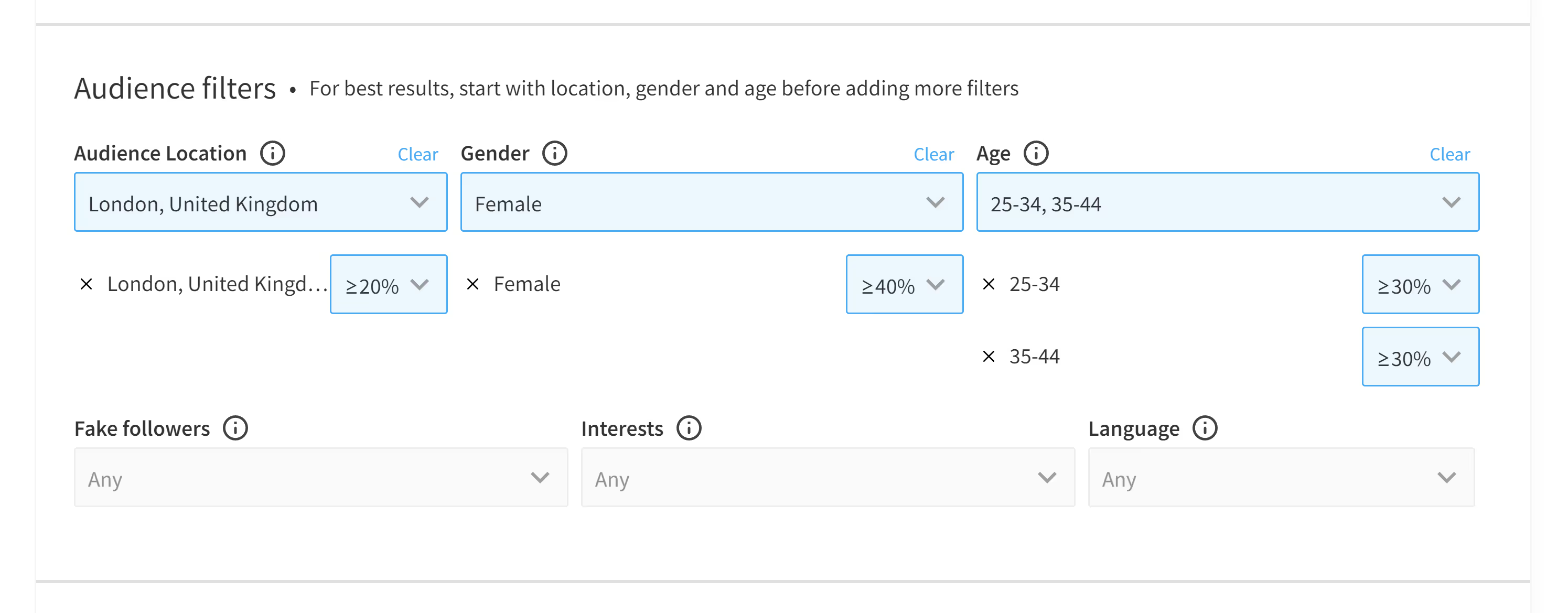
Once you’ve found influencers with the right audience you can begin to narrow down your search by other characteristics. For example, if you have a smaller budget, try only focusing on influencers with a follower count of 1000-10K.
2. Prepare your contracts including usage rights
Before you start recruiting influencers, make sure you have your contracts ready to go. They protect your business and the creators and ensure everyone knows what is expected of them and lower any potential risk.
The most important element for influencer-generated content is usage rights. Usage rights address and clarify who owns the content produced.
Robert Freund, an attorney with a focus on social media and influencer marketing, recommends addressing a few issues as you prepare your agreements.
- Who owns the rights to the content?
- Where can the content be used, and for how long?
- How is the influencer being paid, and when?
- What publicity rights are being transferred?
- Is there an exclusivity clause, and is everyone okay with its scope?
- Does the brand get to approve the content before it goes live?
- Where will you resolve disputes, and what law will apply?
- How do you terminate the agreement, and what happens when you do?
We’re seeing influencers sue companies for false endorsement and misappropriation of likeness more often. So, if you want to repurpose influencer-generated content and use that content on your website, or elsewhere, get permission.
For more on what to include in your agreements, check out our influencer contract templates.
3. Create a brief with clear steps, guidelines, and deadlines
Briefs set the tone, pace, and clarity of your project. And should include just enough information so that creators have the following at their fingertips:
- Company and campaign overviews
- KPIs
- Deliverables
- Timelines
- Review and approval process
- Payment and contact info
Your briefs should also include some inspiration around captions and visual direction. Don’t put in too many restrictions. Influencers know their audience well, have a feeling for what will or won’t work and are experts at creating content. Giving them maximum creative freedom will allow them to create something authentic, and is more likely to succeed.
Learn more and grab our influencer brief template here.
How to track influencer-generated content
Once you start creating influencer-generated content with your brand partners, the volume of content will rise. So how do you keep track and monitor all this sweet sweet new content?
There are two ways:
- Working with more than 15 influencers? Use an influencer monitoring tool
- Working with less than 15 influencers? Use the screenshot-spreadsheet method
(We also created a quick-copy spreadsheet template to help you track influencer-generated content – and anything else you might need to track)
Automatically with a content monitoring tool
Using a tool like Modash will make your life much easier and no detail will fall through cracks once the volume of your IGC content increases.
Here’s how easy it is to track content in Modash:
- Create a monitoring campaign and add influencers.
- Set up tracking for hashtags, mentions, and tags and select a campaign start date.
- Watch as your influencer-generated content flows in.
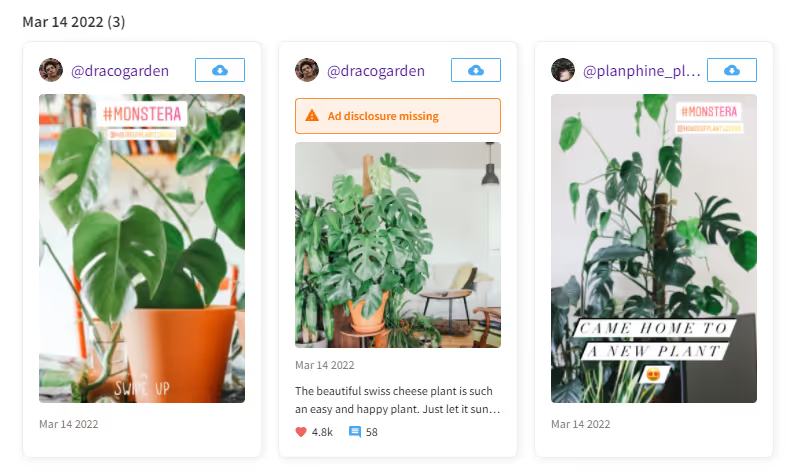
Manually with screenshots and spreadsheets
The tried-and-tested method of screenshotting isn’t going away. And it’s a perfectly acceptable way to track influencer-generated content when you’re starting out. Some marketers even prefer it.
Just remember that with the manual approach you don’t have access to engagement rate data and will have no stats for certain features like Instagram stories.
Here are some tips:
- Follow and subscribe for notifications for the followers on your list. Most platforms offer this functionality. This way you’ll get a notification each time they post.
- Create clearly marked folders to save your screenshots. The hierarchy you create will depend on your own level of organization but we’ve seen these work well.
> Time period (e.g. Q1 2022)
> Campaign name
> Influencer
- Use metadata (tags, labels) in your storage solution for even quicker access. In Google Workspace, use labels to organize your files however you want.
What type of influencer-generated content should you try?
Influencer-generated content can be grouped into a few basic categories that often overlap. Within these categories, there’s tons of room to play.
Here are a few examples:
Educational content e.g. How-to and FAQ content
Influencers can be a great asset when you need to educate a new audience. And it can work for any product or service. Think of lifestyle influencers showcasing their morning routine for beauty products. Or gamers showing their setup for tech products.
The benefit of influencer-generated education content is that it takes your product from your online shelf devoid of context, and shows potential customers how it will fit into their lives.
To help influencers create this kind of content, be sure to give them as much information about your products as you can. This gives them a well of inspiration to draw from and talking points they can use while creating how-to content.
Testimonials/Product reviews
Product reviews or testimonials are often part of how-to’s, or they can be a standalone review.

Giving influencers the freedom to post their uncensored opinions is crucial. Though risky, authenticity is part of the reason that audiences trust and relate to influencers.
Make sure to provide your partners with product specs and FAQs. Also, consider including prompts so they have an idea about how to think of the review. For example, for the hair tool example, Mermade Hair could include prompts like, “How does the tool feel in your hand? Is it light, heavy, just right?”
Unboxing content
Unboxing most often refers to video content where an influencer opens a package to capture their first impressions of a product. This type of content creates curiosity in the audience, so they keep watching.
Before you commission unboxing content from influencers, be sure that your packaging aligns with your brand and is set up for picture-perfect experiences.
For example, if you’re a luxury brand, make sure the unboxing experience feels lux. If you’re a sustainable brand, on the other hand, less is more.

Audience participation (Giveaways, Contests, and Challenges)
Using influencer-generated content for giveaways, contests, and challenges can kickstart a campaign with a bang! And, generate user-generated content!
There are different levels of influencer involvement you can try. Low involvement could be influencers creating videos to simply announce and remind their followers of a giveaway.
Gymshark’s campaign – 66 Days: Change Your Life challenge – saw the sports apparel company partner with sports and athlete influencers to raise awareness of the challenge. Influencers Twin Melody shared the following video generating 751k+ likes and 4950 shares.

At higher levels of involvement, the creator could be part of the prize. For example, imagine partnering with an illustrator, and part of the prize is a portrait of the winner’s dog.
Skit/Comedy
With the rise of TikTok and Instagram Reels, we’re seeing more and more creators try humorous content.
This type of content has high virality potential because the algorithms reward it, and so do audiences. If skits or comedy align with your brand, this type of content can make you super likable.
Take this collaboration between comedian Brian Moller, Stok Cold Brew, and dksDonuts.com for the Awake & Bake Combo Campaign which garnered 12.6 million views!
That’s the power of creators for a brand.

Behind the scenes / Events
Behind-the-scenes content is a way to let influencers and by extension their followers, experience your brand from the inside out.
Often paired with an event, behind-the-scenes content is a double whammy. You build a closer relationship with your partners while giving them an environment and situation where they can create more content for you.
Behind-the-scenes content works well for brands that have an interesting process in making a product.
Events work well for all other types of brands because you can organize an event around anything.
For example, author Anna Todd held a brunch event for an intimate group of book influencers. The event included brunch with Anna Todd herself, a photo booth with a photographer on hand (more content!) and goodie bags.

What’s next?
Now that you understand the benefits of influencer-generated content, check out different ways you can collaborate with influencers, and discover different methods to track your influencer marketing efforts.
If you’re curious to see how easy it can be to keep track of IGC content with Modash, here’s a 14-day free trial just for you!








